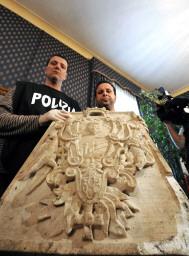An emblem stolen Sunday from the Naples grave of Italian comic genius Toto' was recovered in a tomb raiders' cache on the outskirts of the city Wednesday.
Police said the theft of the marble coat of arms had been commissioned by an unidentified receiver of tomb plunder in the north of Italy who planned to put it in a villa.
''This robbery is part of an illegal trade which traffics artworks from Naples to northern Italy to decorate vintage villas,'' said Naples Flying Squad Chief Vittorio Pisani.
The coat of arms, bearing heraldic devices the once-poor ex-vaudeville artist acquired in 1946, was found buried with other articles stolen from cemeteries, police said.
They suspected some might have come from the tomb of legendary tenor Enrico Caruso, but were awaiting official confirmation.
The Toto' heirloom was handed back to his granddaughter, Diana de Curtis, at a ceremony in Naples police headquarters.
''I have to say thank you to the authorities because they have brought home a piece of the family,'' she said, describing the theft as ''something for which we have suffered greatly and for which granddad will probably have suffered too''.
Ms de Curtis also thanked the ''countless people'' who had sent messages on Facebook, from ''Naples, France and Hong Kong''.
Naples Police Chief Santi Guffre' said ''we made it a priority to recover this important piece of the history of Naples. We got there in time to stop it heading north''.
'GREATEST' ITALIAN FILM COMIC.
Toto' (1898-1967) is widely considered the greatest ever Italian film comedian.
A variety artist with boneless slapstick gestures, a marionette-like silly walk and rubbery face, he rose from the theatres of the backstreets of Naples to become Italy's highest grossing performer.
Many of his improvised gags and oneliners - often alongside straightman Peppino De Filippo - have gone down in Italian cinema history.
De Filippo, the younger brother of the great Neapolitan playwright Eduardo De Filippo, was foil to Toto' in a memorable 'dictation' scene from Toto', Peppino e la Malafemmina (1956) referenced in a homage by Roberto Benigni and Massimo Troisi in Non Ci Resta Che Piangere (1985).
Toto' appeared in his first movie, Fermo con le Mani, in 1937, and went on to star in over 100 films, all considered classics.
Adjusted for inflation, they still top Italy's all-time box office charts and are constantly broadcast on Italian television.
Toto's name was an audience guarantee and appeared in many titles including Toto' Le Moko', Toto' al Giro d'Italia, Toto' Sceicco, Toto' Tarzan, Toto' a colori (the first Italian color film, in 1952) and Toto' truffa.
Other classics, regularly repeated on TV, include Guardie e Ladri, I Tartassati (both featuring another comic great, Aldo Fabrizi) and I Soliti Ignoti.
In the mid-60s, just before he retired, Toto' unveiled dramatic skills in Pier Paolo Pasolini's Uccellacci e Uccellini, earning plaudits from high-brow critics who had slighted his comedies only to celebrate them after his death.
Toto' was still so popular when he died that three funeral services were performed: two mass ceremonies in Rome and Naples plus a packed tribute to an empty casket in the working-class district where he was born.
His image is still plastered in Naples shops and his statuettes are a mainstay of the nativity scenes for which the southern Italian city is famous.
His monumental tomb in the Cimitero del Pianto in the Poggioreale district has become a shrine for fans, many of whom ask him for advice.
Toto's one regret in life was said to be the fact that his films, which relied so heavily on verbal dexterity, never translated well or brought him fame outside Italy.
Perhaps in compensation and because of his claim to be the illegitimate son of a marquis, biographers say, he built a Pharaoh-like tomb in the following name:
''Antonio Griffo Focas Flavio Ducas Comneno Porfirogenito Gagliardi de Curtis of Byzantium, His Imperial Highness, Palatine Count, Knight of the Holy Roman Empire, Exarch of Ravenna, Duke of Macedonia and Illyria, Prince of Constantinople, Cilicia, Thessaly, Ponte of Moldavia, Dardania, Peloponnesus, Count of Cyprus and Epirus, Count and Duke of Drivasto and Durazzo''.
Some said he wanted to record his rise from the bitter poverty of his youth and made the claims in earnest.
But most of his admirers think that, a jester even in death, he was poking fun at a tragicomic heraldic system that still awarded titles despite them being outlawed after WWII.








